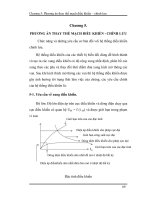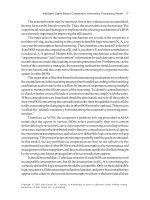Tài liệu Idea Group - Information Management Support Systems And Multimedia Technology P2 docx
Bạn đang xem bản rút gọn của tài liệu. Xem và tải ngay bản đầy đủ của tài liệu tại đây (195.63 KB, 20 trang )
Intelligent Agent-Based Cooperative Information Processing Model 17
Copyright © 2003, Idea Group Inc. Copying or distributing in print or electronic forms without written
permission of Idea Group Inc. is prohibited.
The selected results may be incorrect, but as the evidences are accumulated,
the true facts can be found eventually. Thus, the uncertainties are decreasing. The
experienced rules and strategies to implement the selecting mechanism of a BOS
are extremely important for improving the efficiencies.
The main tasks of the reasoning mechanism are to realize the cooperative
problem solving, and according to the current defeasible logic structure (K
i
,
A
i
), to
carry out the assumption-based reasoning. That a heuristic conclusion P is derived
from BOS
i
means the conjunction of K
i
and A
i
can derive P, and when contradiction
is induced, A
i
is ignored. Meanwhile, the reasoning mechanism calculates the
“argument structure” and “environment” information for each derivative result and
records them as a node, thus making a reasoning structural net. Furthermore, on the
basis of the cooperative strategies, the reasoning mechanism should communicate
the conclusions and the cooperative demands concerning the cooperation to the
agents in other BOSs.
The major tasks of the distributed truth maintaining mechanism are to identify
the contradictions in the reasoning structural net founded according to the reasoning
mechanism and to remove the conflicts by means of cooperation among multiple
agents to maintain the effectiveness of the reasoning. To identify contradictions is
to check whether or not all kinds of constraint conditions comply with the rules.
When contradictions are found and should be eliminated, not only all the nodes in
their own BOS concerning the contradiction nodes must be updated, but also all the
nodes concerning the changing nodes in other BOSs must be updated. This process
is called the “related consistency for maintaining the cooperative reasoning struc-
tural net.”
Therefore, in ACPS, the cooperative problem-solving procedure in MAS
means that the agents in various BOSs select continually their own current
defeasible logic structures, carry out cooperative reasoning according to these
structures, maintain the distributed truth when any contradiction is derived, ignore
the inconsistent assumption set, and select new defeasible logic structures to keep
on reasoning. This process keeps on running repeatedly until the goals are attained.
In this model, the key problems in cooperation are how to use effectively the
experimental results of other BOSs to establish assumption, the maintenance and
management of the assumptions, and how to eliminate rapidly the ill effects brought
by the wrong conclusion propagations when contradictions appear.
It should be noted that: (1) the data structure of each BOS can maintain several
incompatible assumption sets, but all the assumptions in (K
i
, A
i
) constituting the
currently defeasible logic structures should be compatible. Only on these defeasible
logic structures will the reasoning mechanism function, and just when contradictions
appear in the solution, the inconsistent assumption sets are withdrawn and all their
18 Yao & Zhang
Copyright © 2003, Idea Group Inc. Copying or distributing in print or electronic forms without written
permission of Idea Group Inc. is prohibited.
related conclusions are eliminated; (2) the inconsistency may exist among the
current assumption sets of various BOSs in the system, but they do not influence the
effectiveness of the cooperative problem solving; and that is because the coopera-
tive process is a mutual selecting process of each other and the cooperation are
implemented when no contradictions are found in the current assumption sets of
both sides.
DESIGNS AND IMPLEMENTATIONS OF ACPS
WITH BOS MODEL IN THE DTIMS
DTIMS is implemented on a PC computer for distributed traveling situation
assessment tasks. Its organization chart is seen in Figure 1. The DTIMS is
composed of three BOSs. Each BOS represents an independent information
processing subsystem composed of groups of agents, which is distributed on
different physical locations and is linked with the other BOSs mutually in network.
Thus, these BOSs can form hierarchy cooperative organizations, compute in
parallel, and process information cooperatively. This section briefly introduces the
basic structures of this system and then discusses the cooperative problem solving
among the same level BOSs by means of ACPS.
Fundamental Definitions
In the traveling situation assessment problem solving, there may exist uncer-
tainties or mistakes in the primary input information. Therefore, the problem-solving
system must have a mechanism to maintain several possible situation models and to
make the compatible models share the information so as to form the current
situation-analyzing report. In the DTIMS, the ACPS method is used to realize the
cooperative problem solving and implement the mechanism mentioned above.
In the DTIMS, all the information concerning the external environments and all
the conclusions generated in interpreting and analyzing this information are repre-
sented as proposition. They are classified in four types of propositions: precondi-
tion, assumption, derivation, and communication.
The precondition proposition represents the pre-defined domain knowledge
or generally correct propositions. Its truth remains constant during the problem
solving. For example, the topographic knowledge and the features of the recogniz-
able objects in the observing field are unchanged.
The assumption proposition indicates that there is no logic basis and it is
supposed to be correct by the selecting mechanism in the system according to
certain rules. The states of its truth may change during the successful procedure of
Intelligent Agent-Based Cooperative Information Processing Model 19
Copyright © 2003, Idea Group Inc. Copying or distributing in print or electronic forms without written
permission of Idea Group Inc. is prohibited.
problem solving. For example, the platform assumptions, expansion assumptions,
and external assumptions defined in the DTIMS may change in the process of
problem solving.
The derivation proposition means that all the conclusions are derived from
other propositions according to the problem solving rules such as Expanding Rules,
Fission Rules, Recognizing Rules, and so on. One important class of this kind is the
inconsistent proposition. The appearance of this proposition in the situation model
shows mistakes in the situation analysis. For example, that a space group is not
recognized indicates there exists a mistake in the object assumption, and that a
space group movement is incomplete indicates there are mistakes in the expansion
assumption, and so on.
The communication proposition is one that determines to be communicated to
the agent of other BOS in accordance with the cooperative problem-solving rules.
The definition of this class of propositions is mainly used to realize the cooperative
problem solving and the distributed truth maintaining.
Data Structure
The design of the data structures is extremely important to the assumption-
based reasoning and has a direct influence to the problem solving efficiencies. In the
DTIMS, each BOS has a Global Workspace Agent (GWA) who is a CFA and is
in charge of managing shared data structures within the BOS. Their major structure,
called the reasoning-workspace-area, is a complicated two-dimensional area
showing the topographic information. According to the topographical positions, all
the observing object information can be found. Whenever a proposition is derived
in the system, a new node is founded in the reasoning structural net. Its contents are
as follows:
[ node : node name;
node-type : proposition type;
node-content : proposition content;
as-label : proposition label
owner : BOS’s name who derives this node;
inference-description : inference rule descriptions;
ante-list : antecedent node lists that derive this node;
conse-node-list : consequent node list whose deriving depend on this node;
a-struc : argument structure of this node]
The argument structure of a node includes the following contents:
20 Yao & Zhang
Copyright © 2003, Idea Group Inc. Copying or distributing in print or electronic forms without written
permission of Idea Group Inc. is prohibited.
( node-time: founding time of this node;
time: having observing time of this conclusion;
S: distance between the observing position and the center position of the
BOS’s sensor;
agent-list: cooperative problem solving agent list;
CF: times which this proposition has been proved)
All the derivative nodes are linked by pointers according to the deriving
relations so as to form several inference tree structures, i.e., an inference structural
net. On the bottom layer of this net is the two-dimensional array, reasoning-
workspace-area, and the nodes located at the highest abstract level constitute the
current derived situation model.
In the DTIMS, the intermediate results are classified. So, when they are
referred to by topographic positions and result types, the system can ensure that the
same propositions are related on the same nodes in the inference structural net, thus
giving a full play to the assumption-based inference priorities.
Furthermore, by checking the constraint conditions, the system can find the
contradictory states and then analyze the inconsistent assumption sets according to
the contradiction types, the inconsistent context can be recognized and eliminated,
and the assumption-based inference effectiveness is improved.
Basic Cooperative Problem Solving Algorithms
Algorithm implementations can be described from three aspects of selecting,
reasoning, and truth maintaining.
The Selecting Mechanism
The object assumptions and the expansion assumptions are founded respec-
tively by IFA and SAA in the problem solving process. The assumption-based
problem solving tasks are generated simultaneously. The external assumptions are
completed by HA. The main procedure for a assumption being founded is as
follows:
• To check if there are same conclusions in the BOS’s inference structural net.
• If there is a same conclusion in the GWA of this BOS, to increase the
creditability of this conclusion. Then, this procedure ends.
• To calculate respectively their argument structures. If the local conclusion is
in contradiction with an external one, then according to a given rule,
conclusions with greater argument structural creditability are selected. If the
local argument structural creditability is greater, the external conclusion is
Intelligent Agent-Based Cooperative Information Processing Model 21
Copyright © 2003, Idea Group Inc. Copying or distributing in print or electronic forms without written
permission of Idea Group Inc. is prohibited.
discarded, and the procedure ends. If the external message has greater
creditability, a type of truth-maintaining task is generated first, which with-
draws the exiting conclusion, and then changes the external conclusion into an
external assumption, to insert into the inference structural net, thus generating
a problem-solving task based on this new assumption, and this procedure
ends.
• If there is no same conclusion in the local BOS, the external conclusion is
turned into an external assumption, which is then inserted in the inference
structural net so that an assumption-based, problem-solving task is generated
and then the procedure ends.
The Assumption — Based Inference Mechanism
The assumption-based inference mechanism is mainly completed by the IFA
and SAA. The rules to calculate the assumption are explained as follows:
Set the assumption set of the conclusion P is
)(PAS
, and according to the
definition:
If a AS(P), a supposes to be true and AS(P) is consistent, and so P is
creditable;
If a AS(P), a is not creditable or AS(P) is inconsistent, then P is not
creditable.
1. if P is the precondition proposition , then , AS(P) = {}.
2. if P is the assumption proposition, then, when P is an object assumption or
an expansion assumption, AS(P) = {P};
when P is an external assumption, AS(P) = {BOS : P}
AS
(P), where
AS
(P) is the assumption set of P in the original agent, and BOS : P denotes
this external assumption from BOS.
3. If P is a derivation proposition, and a
1
a
2
a
n
P, then
∪
n
j
j
aASPAS
1
)()(
.
4. If P is a communication proposition, the information of AS(P) will be used
as the environmental information to be communicated to the corresponding
cooperative agents together with P.
The problem solving of IFA and SAA includes the following abstract algorithm
descriptive processes:
22 Yao & Zhang
Copyright © 2003, Idea Group Inc. Copying or distributing in print or electronic forms without written
permission of Idea Group Inc. is prohibited.
1. to carry out derivations according to different tasks and the inference rules;
2. to set up nodes for the derived new proposition, to calculate their assumption
sets, and to record the inference rules;
3. to compute the argument structure for new node;
4. to judge whether the new node is contradictory one by the constraint
conditions. If contradictory occurs, then turn to truth maintenance;
5. to refer to whether there is this node in the inference structural net. If there is,
the original node is updated. Otherwise it should be inserted into the net; and
6. to determine whether this node needs to be communicated to other agents in
accordance with the cooperative rules. If so, it is labeled communication
proposition and the corresponding communication tasks are generated.
The Distributed Truth Maintaining Mechanism
By the constraint conditions the DTIMS system can discover the contradictory
states. The contradictory-identifying activities appear mainly in the problem-solving
procedures of IFA, SAA, SDPA and UIA. When any contradiction appears, the
control function is transferred to the distributed Assumption-based Truth Mainte-
nance Agent (ATMA). And the major tasks of ATMA are to eliminate contradic-
tory and to make the problem solver always reason in a defeasible logical structure
(K
i
, A
i
) that results from a conformable assumption set A
i
. The main process is as
follows:
1. to determine the minimum assumption set T that can cause contradictions
according to the contradiction types;
2. to eliminate all the nodes whose labels are the superset of T as contradictory
nodes;
3. to carry out four to six circularly in regard to all the contradictory nodes to be
eliminated;
4. to withdraw these nodes from the inference structural net and to check
whether these nodes are communication propositions;
5. to generate communication tasks if they are communication propositions, and
to make the cooperative agents carry out the distributed truth maintaining;
6. to check whether there are succeeding nodes to these nodes. If there are
succeeding nodes, they are all labeled as contradiction nodes; and
7. after all the contradiction nodes are eliminated, the truth maintaining process
ends.
Intelligent Agent-Based Cooperative Information Processing Model 23
Copyright © 2003, Idea Group Inc. Copying or distributing in print or electronic forms without written
permission of Idea Group Inc. is prohibited.
CONCLUSIONS
It is of great significance to study the organizational structure of the multi-agent
system for the distributed cooperative information processing, which can greatly
quicken the development in many application systems. The examples are distrib-
uted sensor network, distributed network diagnosis, distributed information re-
trieving and collecting, distributed electronic bookstore management, coordinated
robotics or no man driving vehicles, distributed perception processing, and
distributed cooperative situation assessing tasks, etc.
The problem solving in BOS is neither centralized nor all localized, but
distributed dynamically according to the solving tasks. So this method is suitable for
the cooperative problem solving which is real-time, dynamical, and distributed. The
theory behind BOS was tested and evaluated in a series of experiments in the
context of the DTIMS. The main result of the experiments was that the distributed
cooperative information is processed efficiently and the hierarchical system man-
agement is in perfect order, too.
Now we are applying the BOS model to the DTIMS. In the future, we are
going to develop a software platform based the BOS model, called MBOS (Yao
et al., 2001), which means multiply Basic Organization Structure for creating and
deploying organizationally intelligent agents that can cooperate with other agents.
We prepare to use MBOS to build an Organizational Decision Support System
(ODSS).
ACKNOWLEDGMENTS
This research was partly supported by a project from NSFC, which Grant No.
is 79800007.
REFERENCES
Bradshaw, J. M. (1997). Software Agents. Menlo Park, CA: AAAI Press.
Carver, Z., Cvetanovic, Z. & Lesser, V. (1991). Sophisticated cooperation in FA/
C distributed problem solving systems. Proceedings of the 9th National
Conference on Artificial Intelligence (pp. 191-197). Anaheim, CA.
Ciancarini, P. & Wooldridge, M. (2001). Agent-Oriented Software Engineer-
ing. Springer-Verlag Lecture Notes in AI Volume 1957.
de Kleer, J. (1986a). An assumption-based TMS. Artificial Intelligence, 28,
127-162.
24 Yao & Zhang
Copyright © 2003, Idea Group Inc. Copying or distributing in print or electronic forms without written
permission of Idea Group Inc. is prohibited.
de Kleer, J. (1986b). Extending the ATMS. Artificial Intelligence, 28, 163-196.
de Kleer, J. (1986c). Problem solving with the ATMS. Artificial Intelligence, 28,
197-224.
Decker, K. et al. (1995). MACRON: An Architecture for Multi-agent Coopera-
tive Information Gathering. University of Massachusetts: CS Technical
Report 95-11.
Ferber, J. & Gutknecht, O. (1998). A meta-model for the analysis and design of
organizations in multi-agent systems. ICMAS-98, Paris, France, 128-135.
Fox, M. S. (1981). An organizational view of distributed systems. IEEE Transac-
tion on Systems, Man and Cybernetics, 11(1), 70-70.
Jennings, N.R. (2000). On agent-based software engineering. Artificial Intelli-
gence, 117, 277-296.
Jennings, N.R. (2001). An Agent-based Approach for Building Complex Soft-
ware Systems. Communications of the ACM, 44(4).
Kirn, S. (1996). Organization Intelligence and Distributed Artificial Intelligence. In
G.M.P. O’Hare and N.R. Jennings (Eds.), Foundation of Distribution
Artificial Intelligence (pp. 505-526). New York: John Wiley & Sons, Inc.
Mason, C. L. & Johnson, R. R. (1989). DATMS: A framework for distributed
assumption-based reasoning. In L. Gasser and M.N. Huhns (Eds.), Distrib-
uted Artificial Intelligence 2 (pp. 293-318). London: Pitman/ Morgan.
Matsuda, T. (1992). Organizational intelligence: its significance as a process and
as a product. Proceedings of the International Conference on Econom-
ics/Management and Information Technology (pp. 19-222). Tokyo,
Japan.
Mike, P.P. et al. (1991). Intelligent & Cooperative Information Systems.
Proceedings IJCAI-91, Workshop.
Wesson, R., Hayes-Roth, E., Burge, J. W., Statz, C., & Sunshine, C. A. (1981).
Network structure for distributed situation assessment. IEEE Transactions
on Systems, Man and Cybemetics, 11(1), 5-23.
Wooldridge, M. (1999). Intelligence Agent. In G. Weiss (Ed.), Multiagent
System: A Modern Approach to Distributed Artificial Intelligence (pp.
27-78). London: MIT Press.
Wooldridge, M. & Ciancarini, P. (2001). Agent-Oriented Software Engineering:
The State of the Art. In P. Ciancarini & M. Wooldridge (Eds.), Agent-
Oriented Software Engineering. Springer-Verlag Lecture Notes in AI Vol.
1957.
Wooldridge, M., Jennings, N.R. & Kinny, D. (2000). The Gaia Methodology for
Agent-oriented Analysis and Design. Journal of Autonomous Agents and
Multi-Agent Systems, 3(3), 285-312.









